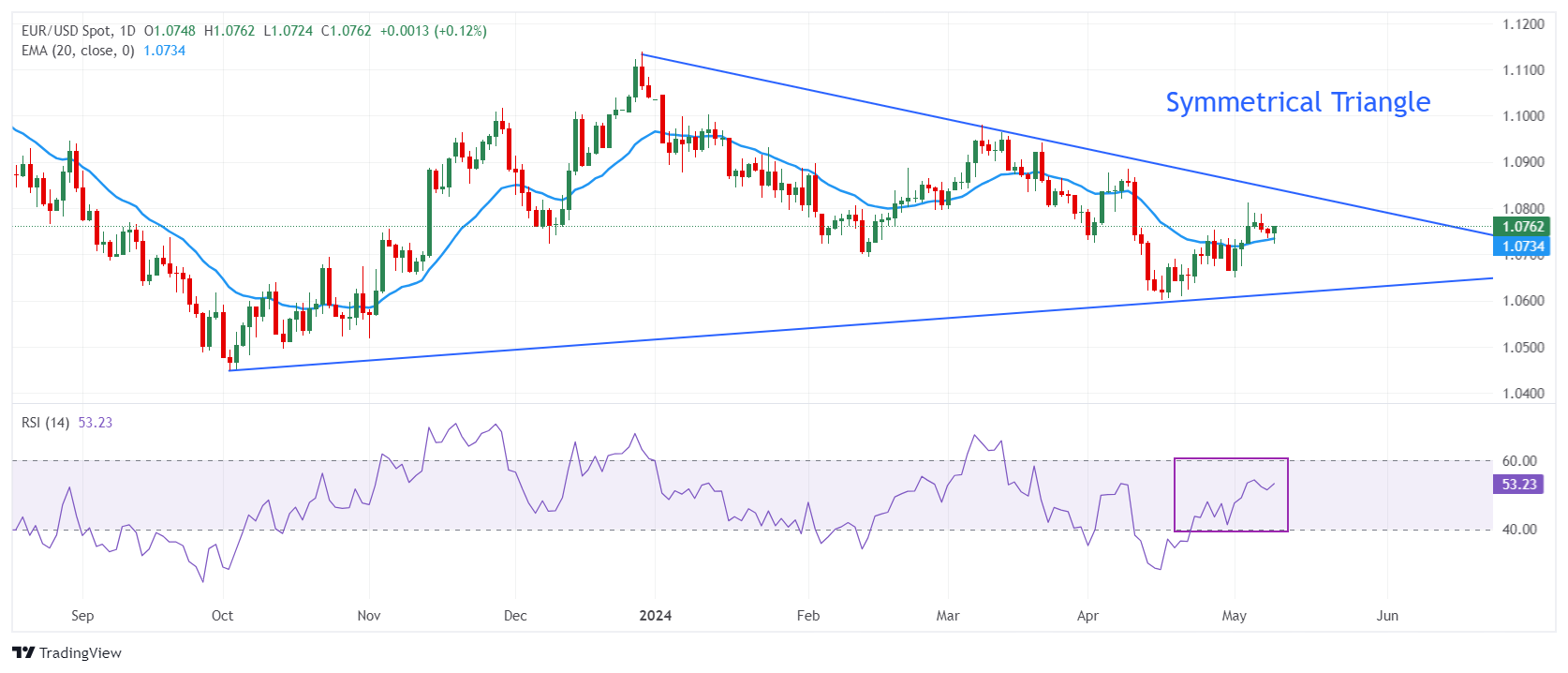- EUR/USD delivers a sharp recovery to 1.0750 as the US Dollar slumps despite Fed’s hawkish interest-rate guidance.
- Fed’s Collins joins Kashkari to support keeping interest rates steady for a longer period.
- The ECB is expected to deliver three rate cuts this year.
EUR/USD discovers strong buying interest near 1.0730 in Thursday’s early New York session. The major currency pair recovers even though speculation that the European Central Bank (ECB) will start lowering its interest rates in June remains firm. A sharp decline in the Eurozone inflation has allowed ECB policymakers to consider that prospect.
Most ECB policymakers also expect that the rate-cut cycle will continue beyond June as inflation is on course to return to the desired rate of 2%, and the service inflation doesn’t seem stubborn anymore. Services inflation softened to 3.7% in April after remaining steady at 4.0% for five straight months. Traders are pricing in three rate cuts by the ECB this year.
Contrary to the majority of ECB policymakers, who broadly agree over expectations of reducing interest rates from June, one of its Governing Council members and Governor of Austria’s central bank, Robert Holzmann, said in Wednesday’s early New York session that he doesn’t see a reason to cut key interest rates “too quickly or too strongly,” Reuters reported.
Daily digest market movers: EUR/USD rebounds as US Dollar falls back
- EUR/USD recovers sharply from 1.0730 as the US Dollar comes under pressure despite US Federal Reserve (Fed) policymakers maintaining hawkish guidance on interest rates.
- On Wednesday, Boston Fed Bank President Susan Collins favored interest rates remaining steady at their current levels until she gets greater confidence that inflation will sustainably return to the desired rate of 2%. Collins added “A slowdown in activity will be needed to ensure that demand is better aligned with supply for inflation to return durably.” Her comments indicated that the US economic outlook is strong even though interest rates remain higher for a longer period.
- Apart from Collins, Minneapolis Fed Bank President Neel Kashkari also remained lean towards maintaining the current interest rate framework as it is for the entire year. Kashkari remains concerned over stalling progress in inflation declining to 2% amid a strong housing market. When asked about an interest rate cut, Kashkari said weakness in the job market could justify it.
- This week, investors look at Fed speakers to project forward moves in the US Dollar due to the absence of top-tier US economic data. However, next week, the major trigger will be producer and consumer inflation data.. Hot inflation numbers would diminish prospects of rate cuts this year.
Technical Analysis: EUR/USD recovers from 1.0730

EUR/USD halts its two-day losing streak on Thursday. The major currency pair finds support near the 20-day Exponential Moving Average (EMA), which trades around 1.0732, suggesting that strength in the near-term outlook is intact.
The shared currency pair exhibits a sharp volatility contraction due to a Symmetrical Triangle formation on a daily timeframe. The upward-sloping border of the triangle pattern is plotted from October 3 low at 1.0448 and the downward-sloping border is placed from December 28 high around 1.1140.
The 14-period Relative Strength Index (RSI) oscillates inside the 40.00-60.00 range, suggesting indecisiveness among market participants.
US Dollar FAQs
The US Dollar (USD) is the official currency of the United States of America, and the ‘de facto’ currency of a significant number of other countries where it is found in circulation alongside local notes. It is the most heavily traded currency in the world, accounting for over 88% of all global foreign exchange turnover, or an average of $6.6 trillion in transactions per day, according to data from 2022. Following the second world war, the USD took over from the British Pound as the world’s reserve currency. For most of its history, the US Dollar was backed by Gold, until the Bretton Woods Agreement in 1971 when the Gold Standard went away.
The most important single factor impacting on the value of the US Dollar is monetary policy, which is shaped by the Federal Reserve (Fed). The Fed has two mandates: to achieve price stability (control inflation) and foster full employment. Its primary tool to achieve these two goals is by adjusting interest rates. When prices are rising too quickly and inflation is above the Fed’s 2% target, the Fed will raise rates, which helps the USD value. When inflation falls below 2% or the Unemployment Rate is too high, the Fed may lower interest rates, which weighs on the Greenback.
In extreme situations, the Federal Reserve can also print more Dollars and enact quantitative easing (QE). QE is the process by which the Fed substantially increases the flow of credit in a stuck financial system. It is a non-standard policy measure used when credit has dried up because banks will not lend to each other (out of the fear of counterparty default). It is a last resort when simply lowering interest rates is unlikely to achieve the necessary result. It was the Fed’s weapon of choice to combat the credit crunch that occurred during the Great Financial Crisis in 2008. It involves the Fed printing more Dollars and using them to buy US government bonds predominantly from financial institutions. QE usually leads to a weaker US Dollar.
Quantitative tightening (QT) is the reverse process whereby the Federal Reserve stops buying bonds from financial institutions and does not reinvest the principal from the bonds it holds maturing in new purchases. It is usually positive for the US Dollar.
Source: https://www.fxstreet.com/news/eur-usd-weakens-on-firm-ecb-rate-cut-bets-firm-us-dollar-202405091058